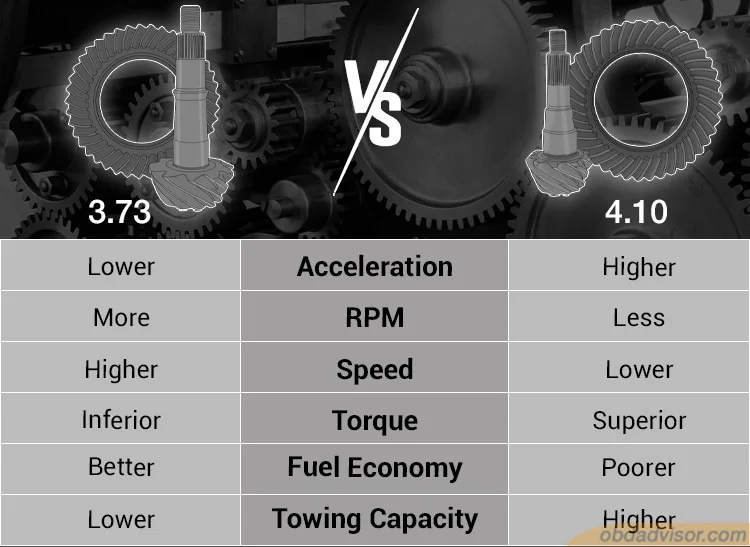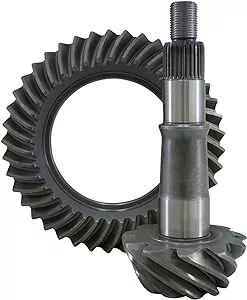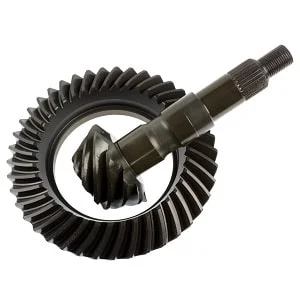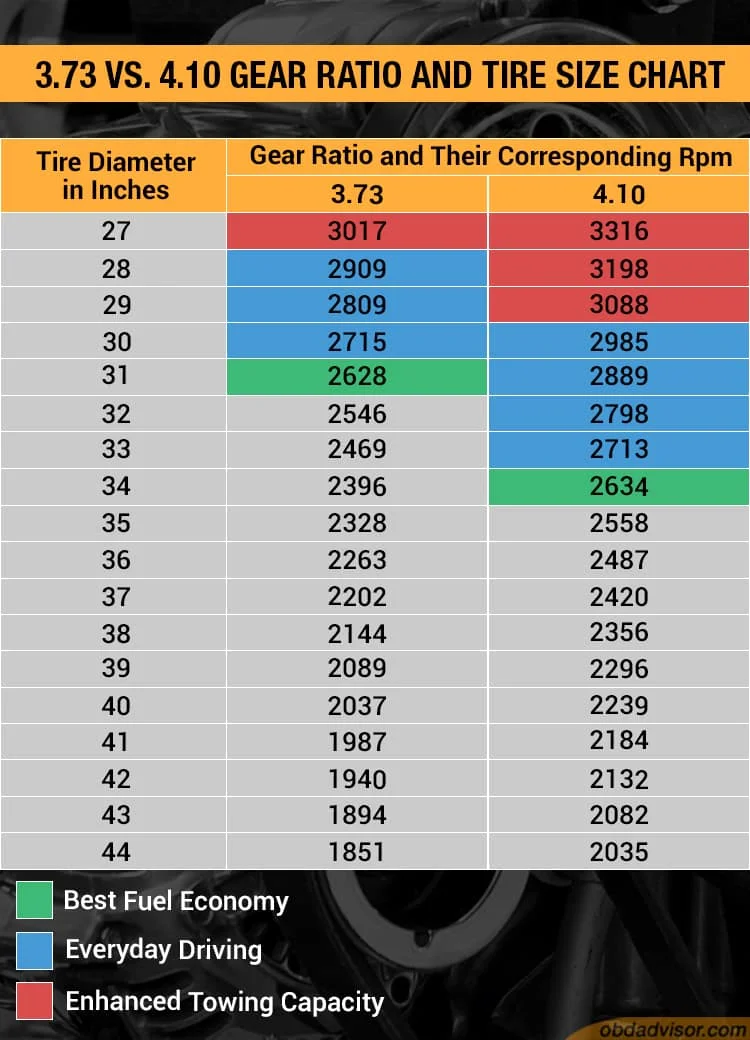Are you the kind of person who loves to immerse yourself in deep research when purchasing a product or before making a choice? Research no further when selecting between 3.73 and 4.10 gear ratios.
Many are oblivious as to what these numbers, 3.73 and 4.10, mean in axle gear ratio. Moreover, the performance features distinguishing the two are known by few.
This post will dig into the roots of how these different gear ratios affect your vehicle’s speed, torque, RPM, towing capacity, and fuel economy. Hopefully, towards the blog’s end, you will be wiser when selecting the desired gear ratio to meet your expectations. Let’s get down to it!
Gear ratio explained
Vehicles are fitted with differential units to transmit engine power to the wheels. The differential unit houses a set of gear that enables the movement of the wheels. These gear sets include the drive shaft’s pinion gear that transmits the engine power to the differential ring gear. The ring gear then drives the wheel axle pinion gear to enable the vehicle to move.
A gear ratio with a more significant number is referred to as the shorter gear ratio, while the one with a smaller number is considered as the taller gear. For instance, between the gear ratios 3.73 and 4.10, the former is the taller gear ratio and the latter is the shorter one.
Torque is the rotational force that is abundant in shorter gears than taller ones. Since torque directly influences the towing capacity, vehicles with shorter gears haul heavier objects than those with taller gears.
Vehicle engines connected to differentials with taller gears work less to generate higher rear wheel horsepower (RWHP). This condition occurs as the engine uses less effort to rotate the wheels of the vehicle. Therefore, the engine’s power can be concentrated on increasing the vehicle’s RPM and, ultimately, its speed.
You can use this formula to calculate the gear ratio if you have information on the number of teeth the ring gear and axle pinion gear have.

A differential unit having 37 ring gear teeth and 9 pinion gear teeth will have an axle gear ratio of 4.11:1. However, in saying and writing, :1 is neglected since the gear ratio is always measured to 1.
It’s possible to know the gear ratio your vehicle has without physical access to the differential housing. By observing the dashboard during driving, you can gather information on the RPM and speed of the vehicle. When you combine this information using tire size, you can easily compute the gear ratio using this formula:

3.73 vs. 4.10 gear ratio comparison chart

3.73 vs. 4.10 gear ratio
Vehicle performance
Acceleration
A vehicle having a 4.10 gear ratio will accelerate and decelerate faster when juxtaposed to a 3.73. This situation results as the 4.10 gear ratio will have to rotate more than 3.73 to make a one-wheel rotation. The higher spin translates to a higher centripetal acceleration, which yields a faster acceleration for the 4.10.
RPM
4.10 has a lower axle wheel RPM than 3.73 since for every 100 axle wheel rotation, the ring gear will rotate 410 times, whereas the ring gear of a 3.73 will only need to spin 373 times for each 100 axle wheel rotation.
Speed
A vehicle having a 3.73 gear ratio will cruise at higher speeds compared to a 4.10. Engines connected with a 3.73 gear ratio will work less to rotate the wheel than those related to a 4.10 gear ratio.
USA Standard Gear 3.73 Axle Ratio Ring & Pinion Gear Set

Price range: $119-$139
Torque
Higher torque is attributed to having a larger ring gear to the axle pinion gear. A 4.10 will have higher torque when compared to a 3.73. The higher torque has several advantages, such as better traction on slippery surfaces and higher towing capacity.
A 4.10 ratio will distribute the torque more evenly to the wheels than a 3.73. The better distribution grants 4.10 superior traction and improved control on the road during cornering and conditions of adverse weather such as muddy areas, rainy situations, and icy places. This quality also makes 4.10 vehicles better at tackling rural areas terrain and for off-road purposes.
Motive Gear 4.10 Axle Ratio Ring and Pinion Set

Price range: $149-$169
Fuel Economy
The poorer fuel economy in 4.10, compared to 3.73, is caused by having the engine work more to rotate the wheels. Therefore, the engine burns more fuel to supply the increased power demand.
Although the weight of 4.10 may be insignificant compared to 3.73, it also contributes to the amount of fuel consumed. 4.10 is heavier than 3.73, making the engine pull some extra strings to deliver the required power.
Towing capacity
The detriment of having better towing capacity is the high cost of fuel. It’s a price of little significance for the increased performance and the freedom that results from it.
The towing capacity is affected by the axle gear ratio and the gearing of the transmission. Shorter gears such as the 4.10 will have better towing capacity than taller gears like 3.73 with the same transmission gearing.
When planning on hauling more than 5,000 pounds, it would be better to go with a 4.10. This gear ratio allows the vehicle to start rolling without using up too much throttle in comparison to a 3.73.
Here is an example to relate how the transmission gearing setup affect the towing capacity;
A D478 6-speed manual transmission vehicle has a maximum towing capacity of 4,500 pounds, whereas an 850RE 8-speed automatic transmission has a towing capacity of 7,000 pounds.
Compared to an 850RE 8-speed automatic transmission having a rear axle of 3.73, a 4.10 model will have 1,000 more towing capacity.
With increased towing power, you will need to match your vehicle with the correct tires. Use tires that have more grip to support the increased load on your car.
3.73 vs. 4.10 gear ratio and tire size chart
Changing tire sizes will automatically affect the power your car delivers and its drivability. The chart below is dedicated to guiding you through ideal RPM ranges while cruising at 65 MPH. It represents value based on the 1:1 manual transmission ratio.
It is worth noting that overdrive tends to have slightly lower RPM while automatic transmission vehicles will have higher RPM ranges for the various tire sizes included.

Conclusion
If you’re the kind of person who spends more time cruising on the highway, the 3.73 rear axle gear ratio will suit you best. Not only will it offer you enormous speed but also grant you better fuel economy. Moreover, they will have higher axle RPM, making them move faster on the track.
4.10 will be a thrill when you’re constantly in the countryside, where speed is unnecessary because of the rough terrain. At a slower pace, 4.10 has a commendable fuel economy. Their higher towing capacity makes them ideal for hauling heavy items. Moreover, their higher acceleration thrives in drag races.
Read more: